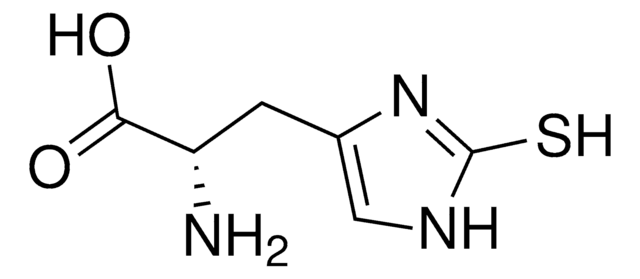M9005
3-Methyl-L-histidine
≥98% (TLC)
Synonym(s):
π-Methyl-L-histidine, 1-Methyl-L-histidine (archaic), 3-(1-Methylimidazol-5-yl)-L-alanine
Sign Into View Organizational & Contract Pricing
All Photos(2)
About This Item
Empirical Formula (Hill Notation):
C7H11N3O2
CAS Number:
Molecular Weight:
169.18
EC Number:
MDL number:
UNSPSC Code:
12352209
eCl@ss:
32160406
PubChem Substance ID:
NACRES:
NA.26
Recommended Products
Product Name
3-Methyl-L-histidine,
Assay
≥98% (TLC)
form
powder
color
white to off-white
mp
254 °C
application(s)
detection
SMILES string
Cn1cncc1C[C@H](N)C(O)=O
InChI
1S/C7H11N3O2/c1-10-4-9-3-5(10)2-6(8)7(11)12/h3-4,6H,2,8H2,1H3,(H,11,12)/t6-/m0/s1
InChI key
JDHILDINMRGULE-LURJTMIESA-N
Looking for similar products? Visit Product Comparison Guide
Related Categories
Application
- Engineering mutually orthogonal PylRS/tRNA pairs for dual encoding of functional histidine analogues.: Exploring innovative genetic engineering techniques, this research advances the use of histidine analogues like 3-Methyl-L-histidine for producing novel proteins with enhanced functionalities, offering vast potential in therapeutic and industrial applications (Taylor et al., 2023).
- Improving the enzymatic activity of l-amino acid α-ligase for imidazole dipeptide production by site-directed mutagenesis.: This investigation enhances the enzymatic synthesis of imidazole dipeptides, crucial for understanding the role of modifications like those seen in 3-Methyl-L-histidine and its impact on biological activities (Kino et al., 2023).
Biochem/physiol Actions
3-Methyl-L-histidine is a non-proteinogenic amino acid and an index of muscle breakdown.
Storage Class Code
11 - Combustible Solids
WGK
WGK 3
Flash Point(F)
Not applicable
Flash Point(C)
Not applicable
Personal Protective Equipment
dust mask type N95 (US), Eyeshields, Gloves
Choose from one of the most recent versions:
Already Own This Product?
Find documentation for the products that you have recently purchased in the Document Library.
Customers Also Viewed
E Roth et al.
Clinical chemistry, 31(8), 1305-1309 (1985-08-01)
We measured amino acid concentrations in plasma and skeletal muscle of three groups of patients with acute hemorrhagic pancreatitis: (a) patients without secondary organ lesions, (b) patients also suffering from kidney damage, and (c) patients in whom the pancreatitis was
M N Goodman
The American journal of physiology, 260(5 Pt 1), E727-E730 (1991-05-01)
The metabolic response to infection includes loss of lean tissue and increased nitrogen excretion. The loss of muscle tissue during infection results in large part from accelerated skeletal muscle protein breakdown. Recent studies suggest that macrophage-derived products secreted during infection
M Hansen et al.
Scandinavian journal of medicine & science in sports, 21(1), 62-72 (2009-11-04)
Oral contraceptive (OC) treatment has an inhibiting effect on protein synthesis in tendon and muscle connective tissue. We aimed to investigate whether OC influence myofibrillar protein turnover in young women. OC-users (24±2 years; Lindynette® n=7, Cilest® n=4) and non-OC-users (controls
Elin Chorell et al.
Journal of proteome research, 8(6), 2966-2977 (2009-03-26)
We have investigated whether postexercise ingestion of carbohydrates in combination with proteins generates a different systemic metabolic response, as compared to the sole ingestion of carbohydrate or water, in the early recovery phase following exercise. In addition, metabolic patterns related
S G A van der Drift et al.
Journal of dairy science, 95(9), 4911-4920 (2012-08-25)
The objective of this study was to obtain information on variation between dairy cows in muscle and fat tissue mobilization around parturition and to study the association between protein and fat mobilization and serum β-hydroxybutyrate (BHBA) concentrations (hyperketonemia) in this
Our team of scientists has experience in all areas of research including Life Science, Material Science, Chemical Synthesis, Chromatography, Analytical and many others.
Contact Technical Service











